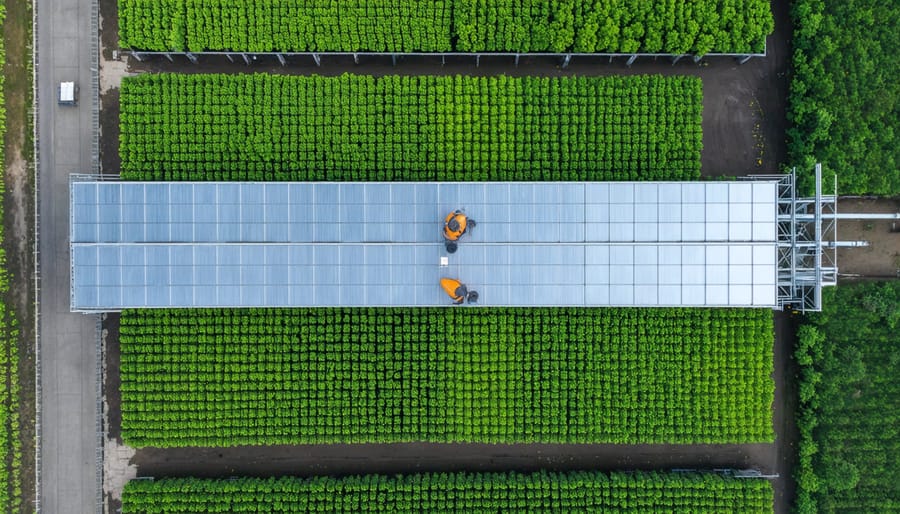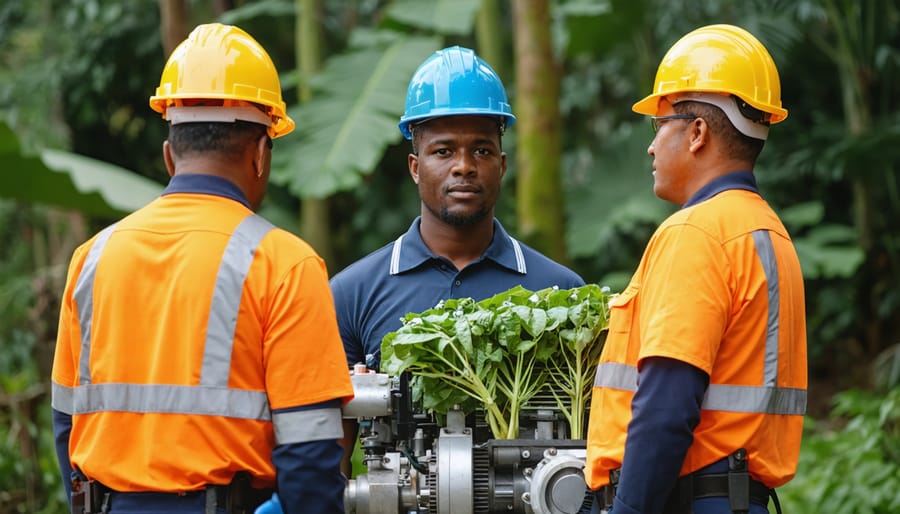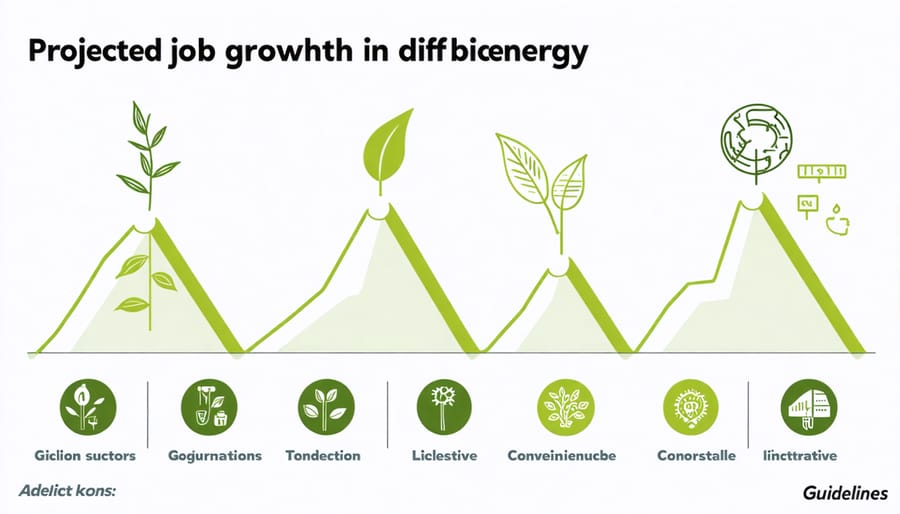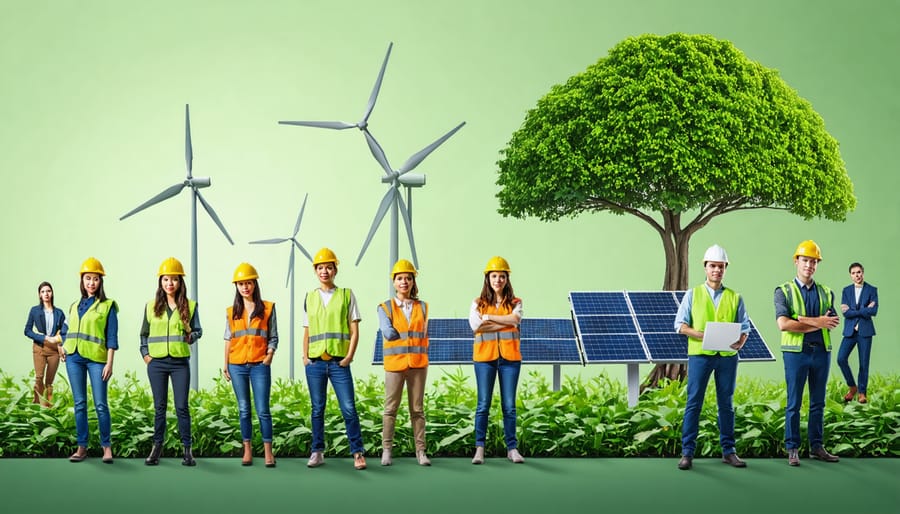Renewable energy jobs have surged by an unprecedented 85% over the past five years, creating over 700,000 new positions across Australia’s clean energy sector. This remarkable growth signals not just an environmental revolution, but a profound transformation of our workforce landscape. As traditional energy jobs decline, the renewable sector now employs more Australians than the coal industry, with bioenergy emerging as a particularly robust employer.
The statistics paint a compelling picture: women now comprise 32% of the renewable energy workforce, up from 24% in 2019, while Indigenous employment has reached 3.8% across solar, wind, and bioenergy projects. These figures reflect a sector that’s not only growing rapidly but actively embracing diversity and inclusion. Regional communities, particularly those transitioning from fossil fuels, have become unexpected beneficiaries, with renewable energy projects creating five jobs for every two lost in conventional energy.
Looking ahead, industry projections suggest the sector could employ over 1.1 million Australians by 2030, with bioenergy specifically expected to generate 26,200 new roles. This green jobs boom represents more than just employment statistics – it’s a powerful indicator of Australia’s progress toward a sustainable, equitable future powered by clean energy innovation.
Current State of Bioenergy Employment in Australia

Employment Distribution Across Regions
Bioenergy employment shows a distinctive pattern across Australia’s geographic landscape, with significant benefits flowing to both urban and rural communities. The sector has become a powerful driver of rural community transformation, creating sustainable job opportunities in areas traditionally dependent on agricultural and mining sectors.
Recent data indicates that approximately 60% of bioenergy jobs are located in regional and rural areas, while 40% are concentrated in metropolitan centres. This distribution reflects the nature of bioenergy operations, where feedstock collection and processing facilities are typically situated near agricultural regions, while research, development, and corporate operations tend to cluster in urban areas.
Rural communities have particularly benefited from this employment pattern, with many towns experiencing a revival through biomass processing facilities. These facilities not only create direct employment opportunities but also support auxiliary services and local businesses. Meanwhile, urban centres have become hubs for bioenergy innovation, hosting technology development centres and corporate headquarters that drive industry growth and create high-skilled positions in engineering, research, and project management.
Key Industry Sectors
The renewable energy sector in Australia showcases diverse employment opportunities across several key areas. Solar energy leads the pack, employing over 29,000 professionals in roles ranging from installation technicians to project managers. Wind energy follows closely, with approximately 17,000 workers engaged in turbine maintenance, site development, and operations management.
Bioenergy has emerged as a promising sector, currently supporting 14,000 jobs across biomass processing, waste-to-energy facilities, and biogas production. Hydropower, Australia’s most established renewable energy source, maintains a steady workforce of 12,000 people in dam operations, engineering, and environmental management.
Battery storage and grid integration have become significant employers, with 8,000 workers specialising in energy storage solutions and smart grid technologies. The emerging green hydrogen sector is rapidly expanding, creating new positions for chemical engineers and production specialists.
Small-scale renewables, including residential solar installations and community energy projects, provide employment for about 15,000 workers, primarily in local businesses and regional areas. This diverse spread of opportunities demonstrates the sector’s robust growth and potential for sustainable career pathways across the nation.
Employment Equity Achievements
Indigenous Employment Opportunities
The bioenergy sector has emerged as a significant opportunity for Indigenous employment and economic development across Australia. Currently, Indigenous-owned and operated renewable energy projects account for approximately 15% of all bioenergy initiatives in remote communities, with this percentage steadily rising year over year.
Several successful programs have demonstrated the sector’s potential for Indigenous employment. The First Nations Clean Energy Network reports that Indigenous participation in renewable energy projects has increased by 45% since 2019, with bioenergy projects leading the way. These initiatives have created diverse roles ranging from biomass collection and processing to facility operations and management positions.
The Aboriginal Carbon Foundation’s latest survey reveals that Indigenous-owned bioenergy projects typically employ 70% Indigenous staff, significantly higher than the industry average. These projects not only provide employment but also help preserve traditional land management practices while creating sustainable energy solutions.
Notable success stories include the Arnhem Land Biomass Project, where local Indigenous communities manage sustainable harvesting operations, creating over 50 full-time positions. Similarly, the Central Desert Biogas Initiative has trained and employed 30 Indigenous workers in various technical and administrative roles.
Looking ahead, industry projections suggest the creation of an additional 1,200 Indigenous-specific positions in bioenergy by 2025. Government initiatives and industry partnerships are focusing on skills development and training programs tailored to Indigenous communities, ensuring long-term career pathways in this growing sector.

Gender Balance in the Workforce
The renewable energy sector is making significant strides in achieving gender balance, though challenges remain. Currently, women represent 32% of the renewable energy workforce in Australia, notably higher than the 22% in traditional energy sectors. This growing representation showcases the industry’s commitment to diversity and inclusion.
Leading renewable energy companies across Australia are implementing targeted initiatives to boost female participation. These include mentorship programs, flexible working arrangements, and partnerships with universities to encourage women to pursue STEM careers. The Women in Renewables (WiR) initiative, launched by the Clean Energy Council, has been particularly successful in supporting female professionals through networking events and leadership development programs.
Success stories are emerging across the sector. In Queensland, solar farms are reporting a steady increase in female engineers and project managers, while Victoria’s wind energy projects have seen a 40% rise in women taking up technical roles over the past three years. These achievements demonstrate the industry’s potential for creating inclusive career pathways.
The benefits of gender diversity are clear: companies with balanced leadership teams report 25% higher profitability and show enhanced innovation capabilities. Looking ahead, the sector aims to achieve 40% female representation by 2025, supported by industry-wide commitments to equal opportunity policies and targeted recruitment strategies.
Regional renewable energy projects are leading by example, with several initiatives in rural areas specifically designed to attract and retain female talent in traditionally male-dominated roles.
Skills Development and Training
Educational Initiatives
Australia’s renewable energy sector is investing heavily in education and training initiatives to build a skilled workforce. Technical and Further Education (TAFE) institutions across the country have developed comprehensive programs focusing on solar installation, wind turbine maintenance, and bioenergy systems. These courses range from short-term certificates to advanced diplomas, providing flexible pathways for career development.
The Clean Energy Council has partnered with leading universities to create specialized renewable energy degrees, while industry associations offer targeted professional development courses. New entrants to the sector can explore various apprenticeship opportunities that combine hands-on experience with structured learning.
Several successful initiatives include the Renewable Energy Skills Partnership program, which has trained over 2,000 professionals in the past year, and the Women in Renewables mentorship scheme, supporting gender diversity in the industry. Industry-specific certifications, such as the Bioenergy Technology Certificate, have become increasingly valuable for career advancement and are recognized nationwide.
These educational pathways are continuously updated to reflect emerging technologies and industry needs, ensuring graduates are ready to contribute to Australia’s growing renewable energy sector.
Industry Partnerships
Leading renewable energy companies across Australia are forging powerful partnerships with educational institutions to create streamlined pathways into the industry. TAFE NSW has partnered with major solar installers to develop specialized training programs, resulting in over 200 graduates securing immediate employment in 2023. Similarly, the Clean Energy Council’s collaboration with universities has established internship programs that achieved an impressive 80% conversion rate to full-time positions.
The Victorian Renewable Energy Hub exemplifies successful industry-education cooperation, bringing together Melbourne University, local manufacturers, and international renewable energy firms. This initiative has created hands-on learning opportunities for students while addressing specific skill gaps in the sector.
In Queensland, the Renewable Energy Training Consortium, comprising five major energy companies and three technical colleges, has pioneered an innovative apprenticeship model. This program combines classroom learning with on-site experience at operational wind and solar farms, preparing students for real-world challenges while maintaining strong employment outcomes.
These partnerships have proven crucial in developing job-ready graduates and ensuring the renewable energy sector has access to skilled professionals who can hit the ground running.

Future Growth Projections
Australia’s renewable energy sector is poised for remarkable growth, with projections indicating a surge in employment opportunities through 2030 and beyond. Industry analysts forecast that the renewable energy workforce could triple in size over the next decade, creating thousands of new positions across various skill levels and specializations.
The bioenergy sector, in particular, shows promising future career opportunities, with estimated job growth of 15-20% annually. This expansion is driven by increased investment in biomass facilities, waste-to-energy projects, and sustainable agriculture initiatives throughout the country.
Emerging roles are expected in specialized areas such as biomass processing, facility operations, and supply chain management. Technical positions in engineering and plant maintenance will see strong demand, while opportunities in project development, environmental compliance, and community engagement are set to expand significantly.
Regional communities stand to benefit substantially, with projections suggesting that 60% of new renewable energy jobs will be created in rural and regional areas. This geographical distribution promises to revitalize local economies and create sustainable employment pathways for regional Australians.
Skills development programs and vocational training initiatives are ramping up to meet this projected demand, ensuring a well-prepared workforce for the growing industry. The sector’s growth also presents opportunities for workers transitioning from traditional energy industries, offering new pathways for experienced professionals to apply their expertise in renewable energy contexts.
The growth of bioenergy in Australia has proven to be a powerful catalyst for employment equity and sustainable job creation. With women now representing over 30% of the workforce in renewable energy sectors, bioenergy is leading the way in fostering inclusive employment practices. Indigenous communities have also found meaningful opportunities through biomass projects, particularly in regional areas where traditional knowledge and land management practices enhance project outcomes.
Looking ahead, the sector’s commitment to diversity and inclusion, coupled with projected industry growth of 15% annually over the next five years, promises even greater employment opportunities across all demographics. The establishment of targeted training programs and apprenticeships suggests a bright future for job seekers from all backgrounds. As Australia continues its transition to renewable energy, bioenergy stands as a shining example of how sustainable practices can create not just environmental benefits, but also foster a more equitable and inclusive workforce for generations to come.

